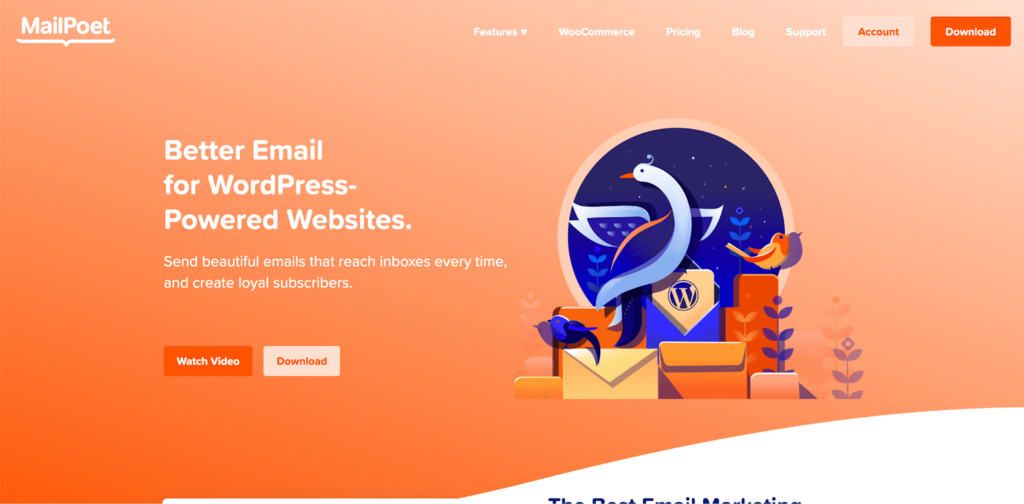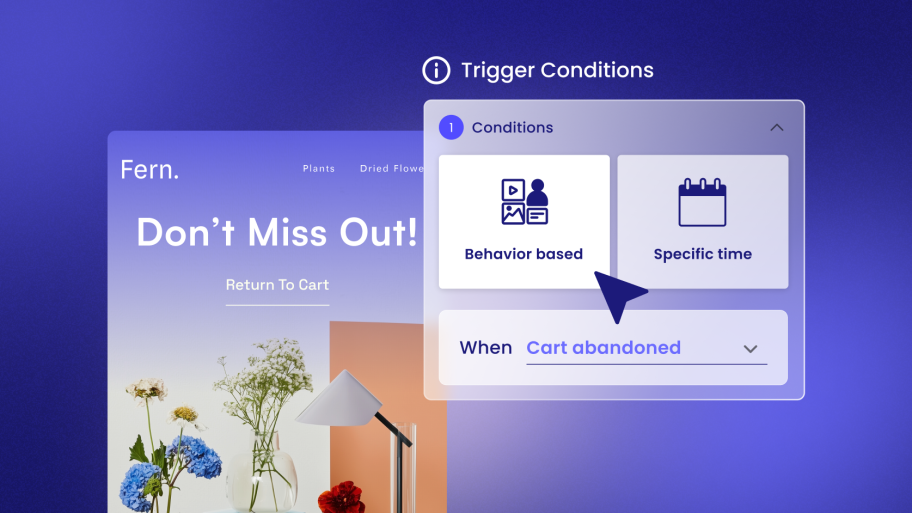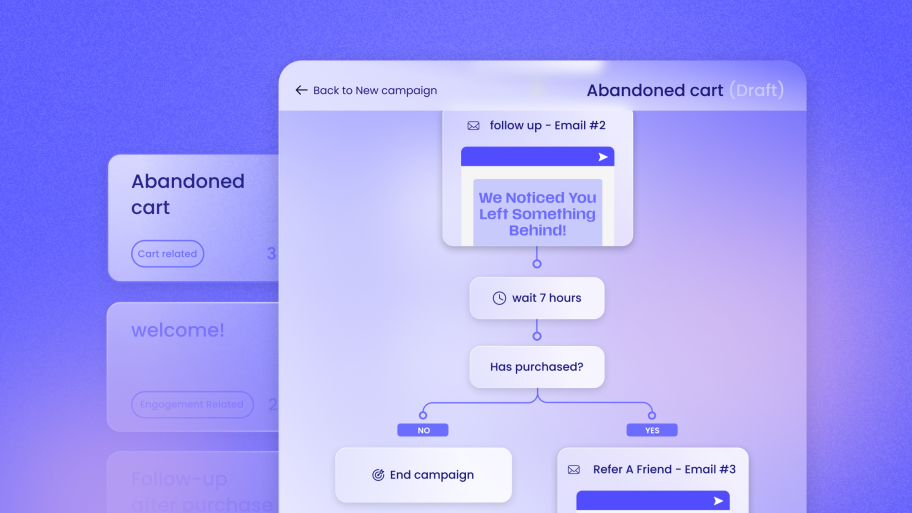This guide cuts through the noise. We’ll explore the 10 best WordPress newsletter plugins available in 2025, giving you an in-depth look at what makes each one stand out. We’ll cover everything from feature sets and ease of use to pricing, helping you find the perfect tool to grow your audience and your business. Whether you’re a freelancer building for clients or a business managing your own marketing, the right plugin is on this list.
What to Look for in a WordPress Newsletter Plugin
Before we dive into the list, let’s establish what makes a newsletter plugin great. Your specific needs will vary, but here are the core criteria we used to evaluate the contenders:
- Ease of Use: How intuitive is the interface? A good plugin should feel like a natural extension of your WordPress dashboard, not a foreign platform you have to fight with.
- Core Features: Does it offer robust list management, segmentation, and automation capabilities? These are the building blocks of effective email marketing.
- Deliverability: What good is an email if it lands in the spam folder? We considered the plugin’s reputation and its use of reliable sending services (SMTP).
- Integration: How well does it play with other tools? Seamless integration with WordPress, popular page builders like Elementor, and e-commerce platforms like WooCommerce is crucial.
- Analytics and Reporting: Can you track your performance? Open rates, click-through rates, and subscriber growth are essential metrics for refining your strategy.
- Scalability & Pricing: Does the plugin offer a fair pricing model that can grow with your business? We looked for options that provide value at every level, from free starters to enterprise-grade plans.
With these factors in mind, let’s get to our top picks for 2025.
1. Send by Elementor

Send by Elementor has quickly become a go-to solution, especially for web creators and agencies already building sites with Elementor. It’s not just an email plugin; it’s a complete, WordPress-native communication toolkit. This distinction is key. It was designed from the ground up to live inside WordPress, eliminating the disconnect that often comes with third-party email marketing platforms.
For professionals building client sites, Send offers a streamlined way to add tangible, ongoing value. You can move beyond the one-off project and provide integrated marketing services that directly impact a client’s bottom line.
Key Features
- Unified Platform: Manage email and SMS campaigns directly from the WordPress dashboard. This unified approach simplifies your workflow immensely. You don’t need to juggle multiple tabs or subscriptions to talk to your audience.
- Advanced Automation: Create sophisticated automation flows with an intuitive visual builder. Welcome series, abandoned cart reminders for WooCommerce, and post-purchase follow-ups can be set up in minutes.
- Deep WooCommerce Integration: This is where Send truly shines for e-commerce. It connects directly to your store’s data, allowing for hyper-targeted campaigns based on purchase history, customer lifetime value, and browsing behavior.
- Powerful Segmentation: Group your audience based on virtually any criteria. Segment by demographics, email engagement, or WooCommerce data to send the right message to the right person every time.
- Actionable Analytics: The reporting dashboard is clean, clear, and focused on the metrics that matter. Track campaign performance, automation effectiveness, and revenue attribution to see exactly what’s working.
- WordPress Native Experience: Because it’s built for WordPress, the user experience is seamless. There are no clunky APIs to configure or external scripts that slow down your site. It just works.
Pros and Cons
Pros:
- Seamless Integration: The native WordPress and WooCommerce integration is best-in-class, providing a smooth and efficient workflow.
- Empowers Web Creators: It provides a clear path for freelancers and agencies to offer recurring revenue services.
- All-in-One Solution: Combining email, SMS, and automation in one place reduces complexity and cost.
- Intuitive Interface: If you know your way around WordPress, you’ll feel right at home with Send.
Cons:
- Best for Elementor Users: While it works with any WordPress site, the synergy is strongest for those already in the Elementor ecosystem.
- Newer Player: As a more recent addition to the market, it’s still building out its library of pre-built templates compared to some older competitors.
Pricing
Send by Elementor offers a tiered pricing structure based on the number of contacts and features.
- Free Plan: Includes up to 500 contacts and 1,000 email sends per month, with basic automation and segmentation.
- Creator Plan: Starts at $9.99/month for up to 1,000 contacts, unlocking advanced automation, SMS marketing, and deeper analytics.
- Business Plan: Custom pricing for high-volume senders and agencies needing priority support and dedicated features.
Best for: Web creators, agencies, and WooCommerce store owners who want a powerful, seamlessly integrated communication platform without ever leaving their WordPress dashboard.
2. MailPoet

MailPoet has been a reliable name in the WordPress newsletter space for years. Recently acquired by Automattic (the company behind WordPress.com and WooCommerce), its integration and stability have only improved. MailPoet’s core appeal is its simplicity and the ability to manage everything—from forms to emails to subscribers—inside WordPress.
It allows you to create and send emails directly from your dashboard and even offers its own sending service to ensure high deliverability, a feature that sets it apart from many plugins that require a third-party SMTP.
Key Features
- WordPress-Centric Design: Create and manage newsletters using an interface that mirrors the WordPress block editor, making it instantly familiar.
- Integrated Sending Service: MailPoet offers its own reliable sending infrastructure, which is free for up to 1,000 subscribers. This removes the headache of configuring a separate service like SendGrid or Amazon SES.
- WooCommerce Functionality: Send automated emails for abandoned carts, first purchases, or to customers who bought specific products.
- Automation Workflows: Welcome emails, post notifications, and subscriber anniversary emails can be automated to engage your audience consistently.
- List Segmentation: Segment your lists based on user behavior, such as email opens or link clicks, to personalize your communication.
Pros and Cons
Pros:
- Excellent User Experience: The interface is clean, intuitive, and deeply integrated with the WordPress UI.
- Reliable Deliverability: The built-in sending service is a major advantage, especially for beginners.
- Generous Free Plan: The free tier is one of the best available, making it a great starting point for new blogs or businesses.
Cons:
- Limited Advanced Features: While strong on the basics, its automation and segmentation capabilities aren’t as deep as dedicated platforms like Send by Elementor.
- Can Be Resource-Intensive: On some shared hosting environments, sending large campaigns directly from your site can impact performance.
Pricing
MailPoet’s pricing is straightforward and scales with your subscriber count.
- Free Plan: Free for up to 1,000 subscribers with the MailPoet sending service.
- Creator Plan: Starts at $8/month (billed annually) for up to 500 subscribers, offering enhanced WooCommerce features and analytics.
- Business Plan: Starts at $10/month (billed annually) for up to 500 subscribers, adding detailed engagement statistics and priority support.
Best for: Bloggers, small business owners, and WooCommerce stores looking for a simple, reliable, and well-integrated newsletter solution with a fantastic free offering.
3. FluentCRM
FluentCRM is another self-hosted email marketing automation plugin for WordPress. “Self-hosted” means it runs entirely on your server, giving you complete ownership of your data. This is a significant advantage for businesses concerned with privacy and wanting to avoid the monthly fees associated with SaaS platforms.
It positions itself as a full-featured CRM and marketing automation tool, not just a newsletter plugin. This makes it incredibly powerful, but it also requires you to configure a third-party email sending service (like Amazon SES, SendGrid, or Mailgun) to handle deliverability.
Key Features
- 360° Contact View: Get a complete profile of your subscribers, including their contact information, purchase history, support tickets, and email interactions, all in one place.
- Email Campaign Management: Run standard email campaigns, A/B test subject lines, and analyze detailed performance reports.
- Granular Segmentation: Create dynamic segments based on a wide range of data points, from list membership and product purchases to custom fields.
- Visual Automation Funnels: Build complex automation sequences using a drag-and-drop editor. You can trigger funnels based on user actions, such as form submissions or new orders.
- Extensive Integrations: FluentCRM integrates with dozens of popular WordPress plugins, including LMS (like LearnDash), membership (like MemberPress), and form builders (like Fluent Forms).
Pros and Cons
Pros:
- No Subscriber Limits & No Monthly Fees: You pay a flat annual fee for the plugin, regardless of how many contacts you have. Your only recurring cost is for your chosen email sending service, which is typically very low.
- Complete Data Ownership: All your subscriber data stays on your WordPress site.
- Incredibly Powerful: The combination of CRM and marketing automation is unmatched by most other plugins.
Cons:
- Requires Technical Setup: You must configure an external SMTP service. While not overly difficult, it’s an extra step that can be a hurdle for non-technical users.
- Potential for Server Strain: Since it’s self-hosted, sending large email volumes can put a load on your web server if it’s not properly optimized.
Pricing
FluentCRM is a premium-only plugin with a simple pricing model.
- Single Site License: $129/year.
- 5 Site License: $249/year.
- 50 Site License: $499/year.
All plans include all features, with the only difference being the number of sites.
Best for: Marketers, agencies, and businesses that want maximum power and data ownership and are comfortable setting up a third-party sending service.
4. Newsletter
The Newsletter plugin is one of the most popular free options in the WordPress repository, and for good reason. It offers a solid set of features out of the box, with the ability to extend its functionality through premium add-ons. It’s a great choice for those who want to start simple and add more power as they grow.
Like FluentCRM, it’s self-hosted, so you’ll need an external SMTP service for reliable deliverability, but its core functionality is robust and easy to manage.
Key Features
- Visual Drag-and-Drop Composer: Build beautiful, responsive newsletters without touching a line of code.
- Unlimited Subscribers & Emails: The free version doesn’t limit your list size or the number of emails you can send (though your hosting and SMTP provider might).
- Subscription Forms & Pop-ups: Create customizable forms and pop-ups to capture new leads.
- Single and Double Opt-in: Stay compliant and build a quality list with support for both opt-in methods.
- Detailed Statistics: Track opens, clicks, and subscriber growth to measure your success.
- Premium Add-ons: Extend the plugin with features like automation, advanced reporting, and integrations with WooCommerce and other plugins.
Pros and Cons
Pros:
- Powerful Free Version: The core plugin is free and packed with essential features.
- Highly Customizable: The drag-and-drop editor and extensive settings give you a lot of control over your campaigns.
- Modular Approach: You only pay for the advanced features you need through the premium extensions.
Cons:
- SMTP Required: Like other self-hosted options, you need to set up a separate sending service for best results.
- Premium Add-ons Can Add Up: While the core is free, building a full-featured system with automation and integrations can become costly.
Pricing
- Free Version: Available from the WordPress repository.
- Blogger Plan: Starts at $69/year for 3 sites, includes 1 year of updates and support, and a bundle of premium add-ons.
- Agency Plan: $269/year for unlimited sites and all premium add-ons.
Best for: DIY marketers and bloggers who want a free, flexible starting point with the option to scale up with premium features over time.
5. Brevo (formerly Sendinblue)
Brevo is a full marketing suite that offers a very capable WordPress plugin. Unlike the self-hosted options, Brevo is a SaaS platform, meaning the heavy lifting (like email sending) happens on their powerful servers. This makes it a highly reliable and scalable solution.
The WordPress plugin seamlessly syncs your contacts and allows you to build forms, manage campaigns, and set up automations directly from your dashboard. Brevo’s offering extends beyond email to include SMS, chat, a CRM, and even landing pages.
Key Features
- All-in-One Marketing Platform: Access email, SMS, live chat, CRM, and more from a single account.
- High Deliverability: As a dedicated email service provider (ESP), Brevo has a strong focus on ensuring your emails reach the inbox.
- Transactional Emails: Send critical emails like password resets and order confirmations through a reliable, high-speed channel.
- Marketing Automation: Create multi-step workflows based on user behavior, page visits, or email engagement.
- Generous Free Plan: The free tier allows for 300 emails per day and unlimited contacts, which is excellent for businesses just starting out.
Pros and Cons
Pros:
- Excellent Deliverability: Offloading sending to Brevo’s servers ensures reliability and protects your server’s reputation.
- Comprehensive Feature Set: The platform covers nearly every aspect of digital marketing.
- Scalable: It can handle everything from a small blog to a massive enterprise.
Cons:
- Interface Can Be Complex: With so many features, the main Brevo interface (outside of WordPress) can feel overwhelming for beginners.
- Daily Sending Limits on Free Plan: The 300 emails/day limit on the free plan can be restrictive for sending newsletters to a list larger than 300.
Pricing
Brevo’s pricing is based on email volume, not contacts.
- Free Plan: Unlimited contacts, 300 emails/day.
- Starter Plan: Starts at $25/month for 20,000 emails/month and no daily sending limit.
- Business Plan: Starts at $65/month, adding A/B testing, advanced automation, and phone support.
Best for: Small to medium-sized businesses that want a powerful, all-in-one marketing platform with excellent deliverability and don’t mind managing it through a third-party interface.
6. Mailchimp for WordPress (MC4WP)
Mailchimp is one of the biggest names in email marketing, and this plugin is the most popular way to connect it to a WordPress site. It’s important to note that MC4WP is not a full newsletter plugin in itself; it’s a bridge. It allows you to create beautiful, effective sign-up forms and sync your WordPress users with your Mailchimp audience.
The actual email creation and sending happens within the Mailchimp platform. This is a great setup for those who love Mailchimp’s interface and deliverability but want a simple way to grow their lists from their WordPress site.
Key Features
- Seamless Form Integration: Connect with a variety of form types on your site, including comments, contact forms, and checkout pages.
- User-Friendly Form Builder: Create good-looking sign-up forms that are easy to customize.
- E-commerce Integration: Sync your WooCommerce customers and order data to your Mailchimp account for targeted campaigns.
- Style Builder: A premium feature that helps you design forms that perfectly match your site’s branding.
- Detailed Reports: See which sign-up methods and pages are performing best.
Pros and Cons
Pros:
- Simple and Reliable: The plugin does one job—connecting WordPress to Mailchimp—and it does it exceptionally well.
- Leverages Mailchimp’s Power: You get the benefit of Mailchimp’s world-class deliverability, templates, and analytics.
- Extensive Integrations: It works with dozens of other plugins right out of the box.
Cons:
- Requires a Mailchimp Account: This is not an all-in-one WordPress solution. All your campaign management happens off-site.
- Mailchimp’s Pricing: Mailchimp’s free plan has become more restrictive over the years, and its paid plans can be more expensive than competitors, especially as your list grows.
Pricing
- MC4WP Plugin: The core plugin is free. A premium version with advanced features like the style builder and e-commerce integration starts at $59/year.
- Mailchimp Service: Mailchimp has a free plan for up to 500 contacts. Paid plans start at $13/month.
Best for: Anyone who already uses and loves Mailchimp and just needs a robust, reliable way to integrate it with their WordPress site.
7. HubSpot WordPress Plugin
HubSpot is a titan in the CRM and marketing automation world. Their WordPress plugin is a free, powerful tool that brings much of HubSpot’s functionality directly into your dashboard. It’s far more than a newsletter plugin; it’s a full suite of marketing, sales, and service tools.
With the plugin, you can build forms, manage contacts in the HubSpot CRM, engage visitors with live chat, and, of course, send email newsletters. The heavy lifting is done on HubSpot’s servers, ensuring speed and deliverability.
Key Features
- Free CRM: The foundation of the plugin is HubSpot’s free CRM. Every contact you capture is automatically stored and enriched with data.
- Email Marketing: Build and send newsletters using a drag-and-drop editor. The free plan includes up to 2,000 email sends per month.
- Forms & Pop-ups: Create custom forms and pop-ups to capture leads and sync them directly to your CRM.
- Live Chat & Chatbots: Engage with website visitors in real-time to answer questions and generate leads.
- Built-in Analytics: Get a detailed dashboard showing how your marketing efforts are performing and how they contribute to the bottom line.
Pros and Cons
Pros:
- Incredibly Generous Free Plan: The amount of functionality HubSpot gives away for free is astounding. The CRM alone is a game-changer for many businesses.
- Truly All-in-One: It seamlessly combines CRM, email, chat, and forms into a single, cohesive system.
- Scalable: HubSpot can support you from your first contact to millions of customers.
Cons:
- Can Lead to Vendor Lock-in: The system works so well together that moving away from it can be difficult and costly down the line.
- Paid Plans Are Expensive: While the free plan is great, upgrading to HubSpot’s paid Marketing Hub can be a significant financial jump.
Pricing
- HubSpot Plugin: The plugin itself is free.
- HubSpot Platform: The free plan includes the CRM, 2,000 email sends/month, live chat, and forms. Paid plans (Marketing Hub Starter) begin at $45/month (billed annually).
Best for: Businesses of all sizes that are serious about growth and want a unified platform for all their marketing, sales, and service activities.
8. Jackmail
Jackmail is a WordPress-native newsletter plugin that comes with a unique feature: a built-in, professional SMTP service. This means you get the convenience of creating emails inside WordPress and the high deliverability of a dedicated sending service, all in one package.
It has a modern, user-friendly interface and a drag-and-drop editor that makes designing emails straightforward. It also offers some neat automation features, like automated post notifications.
Key Features
- Integrated SMTP: No need to sign up for a separate sending service. Jackmail handles all the technical aspects of deliverability for you.
- Drag-and-Drop Editor: A clean and intuitive editor with a good selection of pre-made templates.
- Automation: Set up welcome emails and automated newsletters to send your latest blog posts.
- WooCommerce Integration: Connect with your store to send targeted campaigns.
- Detailed Statistics: Track your campaign performance with clear, easy-to-understand reports.
Pros and Cons
Pros:
- Simplicity: The all-in-one nature of the plugin makes it incredibly easy to get started.
- Good Deliverability: The integrated SMTP service is reliable and helps keep your emails out of the spam folder.
- WordPress Native: The entire workflow stays within your dashboard.
Cons:
- Sending Limits: The free plan is quite limited, and the paid plans are based on sending volume, which can get pricey.
- Fewer Advanced Features: It lacks the deep segmentation and complex automation capabilities of tools like Send by Elementor or FluentCRM.
Pricing
Jackmail’s pricing is based on the number of emails you send per month.
- Free Plan: 50 emails/day.
- Paid Plans: Start at $19/month for up to 5,000 emails.
Best for: Users who prioritize simplicity and want a WordPress-native solution with built-in SMTP, without the need for advanced automation.
9. Omnisend
Omnisend is a powerful marketing automation platform built specifically for e-commerce. While it’s a SaaS platform, its WordPress plugin provides deep integration with WooCommerce, making it a top contender for online stores.
Its strength lies in its “omnichannel” approach. You can combine email, SMS, push notifications, and even social media ads into a single, cohesive automation workflow. This allows you to create a truly seamless customer journey.
Key Features
- E-commerce Centric Automation: Comes with a library of pre-built workflows for abandoned carts, welcome series, cross-selling, and more.
- Omnichannel Workflows: Reach customers on their preferred channel by integrating email, SMS, and push notifications.
- Advanced Segmentation: Segment your audience based on shopping behavior, campaign engagement, and profile data.
- Dynamic Content: Personalize your emails with product recommendations based on what a customer has viewed or purchased.
- Robust Reporting: Track revenue attribution to see exactly how much money your campaigns are making.
Pros and Cons
Pros:
- Unmatched for E-commerce: The features are tailor-made for online stores and are designed to drive sales.
- Powerful Omnichannel Approach: The ability to combine multiple channels in one workflow is a huge advantage.
- Excellent Templates and Workflows: The pre-built resources make it easy to get sophisticated campaigns up and running quickly.
Cons:
- Less Suited for Non-E-commerce Sites: If you’re a blogger or a service-based business, many of its core features won’t be relevant.
- Can Be Expensive: The pricing is higher than many other options, especially on the Pro tier which unlocks SMS credits.
Pricing
- Free Plan: Up to 250 contacts, 500 emails/month, and 60 SMS credits.
- Standard Plan: Starts at $16/month for up to 500 contacts and 6,000 emails/month.
- Pro Plan: Starts at $59/month, adding more SMS credits, advanced reporting, and priority support.
Best for: Serious WooCommerce store owners who want a powerful, sales-focused marketing automation platform with omnichannel capabilities.
10. Icegram Express (formerly Email Subscribers & Newsletters)
Icegram Express is a straightforward, easy-to-use plugin that focuses on the essentials of list building and broadcasting. It’s a great no-frills option for those who just want to collect subscribers and send them updates without getting bogged down in complex features.
It’s a self-hosted plugin, so you have control over your data, but you’ll need to pair it with an SMTP service for the best deliverability. It’s designed to be lightweight and simple to manage.
Key Features
- Simple Setup: Get up and running in minutes.
- Broadcasts & Post Notifications: Send one-off newsletters or automatically notify subscribers of new blog posts.
- List Management: Easily manage your subscriber lists and view their status.
- Basic Forms: Includes a simple subscription form widget to place in your sidebar or footer.
- Pro Version: The paid version adds features like email scheduling, user role-based sending, and better analytics.
Pros and Cons
Pros:
- Very Easy to Use: It’s one of the simplest plugins on this list, making it perfect for beginners.
- Lightweight: It won’t bloat your WordPress site with unnecessary features.
- Free and Effective: The free version provides all the core functionality needed for basic newsletter management.
Cons:
- Limited Features: It lacks any real automation, segmentation, or advanced design capabilities.
- Requires SMTP: Like other self-hosted plugins, you need to bring your own sending service.
Pricing
- Free Version: Available in the WordPress repository.
- Pro Plan: Starts at $6.50/month (billed annually), adding features like cron-based sending, more form designs, and premium support.
Best for: Bloggers and small site owners who need a simple, free, and lightweight way to send basic newsletters and post notifications.
Comparison Table: Top 10 WordPress Newsletter Plugins
| Plugin | Type | Best For | Key Feature | Pricing Model |
| Send by Elementor | WordPress Native | Web Creators & WooCommerce | Unified Email/SMS, Deep WooCommerce Integration | Freemium / Contact-based |
| MailPoet | WordPress Native | Bloggers & Small Business | Built-in Sending Service, Simple Interface | Freemium / Contact-based |
| FluentCRM | Self-Hosted | Marketers & Agencies | Full CRM, Unlimited Contacts, Data Ownership | Annual Fee |
| Newsletter | Self-Hosted | DIY Marketers & Bloggers | Powerful Free Version, Modular Add-ons | Freemium / Annual Fee |
| Brevo | SaaS Platform | Small to Medium Businesses | All-in-One Marketing (Email, SMS, Chat, CRM) | Freemium / Volume-based |
| MC4WP | Connector Plugin | Mailchimp Users | Seamless Mailchimp Integration | Freemium / Annual Fee |
| HubSpot | SaaS Platform | Growth-Focused Businesses | Free CRM, All-in-One Marketing Suite | Freemium / Contact-based |
| Jackmail | WordPress Native | Users Prioritizing Simplicity | Integrated SMTP Service | Freemium / Volume-based |
| Omnisend | SaaS Platform | E-commerce Stores | Omnichannel Automation (Email, SMS, Push) | Freemium / Contact-based |
| Icegram Express | Self-Hosted | Beginners & Basic Blogs | Lightweight and Simple | Freemium / Annual Fee |
How to Choose the Right WordPress Newsletter Plugin for You
We’ve covered a lot of ground. Now, how do you make the final call? Ask yourself these four questions:
1. What is my primary goal?
- Driving Sales (E-commerce): Look at Send by Elementor, Omnisend, or MailPoet. Their deep WooCommerce integrations are designed to boost revenue.
- Growing a Blog Audience: MailPoet, Newsletter, or Icegram Express are excellent for their simplicity and focus on post notifications.
- Building a Full Marketing System: HubSpot, FluentCRM, or Brevo offer comprehensive CRM and automation features that go far beyond simple newsletters.
2. What is my technical comfort level?
- Beginner (I want it to just work): Choose a plugin with a built-in sending service like MailPoet, Jackmail, or a SaaS platform like Brevo or HubSpot.
- Intermediate (I’m comfortable with some setup): A self-hosted option like FluentCRM or Newsletter combined with an SMTP service gives you more power and control.
- Professional (I build sites for clients): Send by Elementor is designed specifically for this workflow, offering a powerful, integrated solution you can easily manage and monetize.
3. What is my budget?
- Free to Start: MailPoet, HubSpot, and Brevo have the most generous and functional free plans.
- Predictable Annual Cost: FluentCRM offers a flat annual fee for unlimited contacts, which can be incredibly cost-effective at scale.
- Scalable Investment: Send by Elementor and Omnisend offer tiered plans that grow with your business, ensuring you only pay for what you use.
4. Where do I want to manage my marketing?
- 100% Inside WordPress: If you want a truly native experience, Send by Elementor, MailPoet, and FluentCRM are your best bets. They keep you inside the dashboard you already know.
- I’m Okay with a Hybrid Approach: Using a connector like MC4WP or the HubSpot plugin allows you to leverage a powerful external platform while still managing subscribers from your site.
Conclusion
Choosing the right newsletter plugin is a critical step in building a successful online presence. The direct, personal connection that email provides is invaluable for nurturing leads, engaging readers, and driving sales.
For web creators and WooCommerce stores seeking a modern, powerful, and seamlessly integrated solution, Send by Elementor stands out as the top choice for 2025. Its WordPress-native design and focus on empowering professionals make it a standout communication toolkit.
However, the “best” plugin is ultimately the one that fits your unique goals, budget, and workflow. Whether you need the all-in-one power of HubSpot, the data ownership of FluentCRM, or the elegant simplicity of MailPoet, the WordPress ecosystem has a solution for you. Use this guide to weigh your options, test a few free versions, and make a confident choice to start building your audience today.




